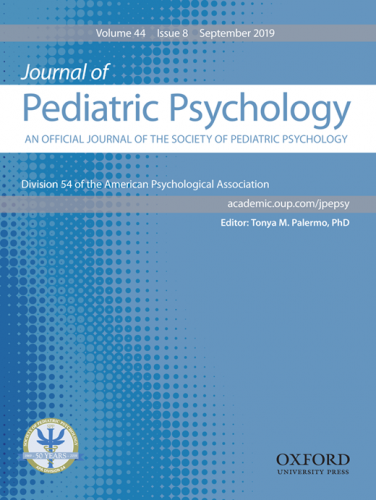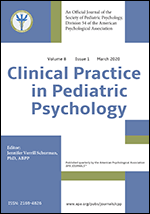Assessment Resource Sheet : Pediatric Pain
Assessment of pediatric pain can be conducted in a number of ways including self-report, questionnaires and diaries, and behavioral observation measures. Most research in pediatric populations is on pain intensity, with few studies assessing other important domains or dimensions of pain (McGrath et al., 2008), such as location, sensory and affective qualities, temporal characteristics, and impact on functioning. The present list emphasizes pain intensity measures in children three years of age and older.
This list is based on measures summarized in several recent reviews (i.e., Cohen et al., 2008; Huguet, Stinson, & McGrath, 2010; Stinson, Kavanagh, Yamada, Gill, & Stevens, 2006; von Baeyer & Spagrud, 2007). All measures are classified as well-established assessment, approaching well-established assessment, and promising assessment as detailed in the Cohen, La Greca, Blount, Kazak, & Holmbeck (2008) paper. When available, information on where to obtain the measure is included in brackets after the name of each measure. Age ranges are included in parentheses. Key references are included after each table and are cited with superscripts in the tables.
Unidimentional Self-Report Scales of Pain Intensity
|
Assessments |
Well-established |
Approaching |
Promising |
|
Visual Analog Scale (VAS)1 (ages 7-adult) |
X | ||
|
OUCHER2,3 (ages 3-12) |
X | ||
|
Wong-Baker FACES Pain Rating Scale4 (ages 4-18) |
X | ||
|
Faces Pain Scale-Revised (FPS-R)5 (ages 4-16) |
X | ||
|
Pieces of Hurt (Poker Chip Tool)6 (ages 4-7) |
X | ||
|
Numerical Rating Scale7 (ages 8-adult) |
X | ||
|
Colored Analog Scale8 (ages 7-adult) |
X |
Questionaires and Diaries
|
Assessments |
Well-established |
Approaching |
Promising |
|
Headache Diary9 (ages 8-17) |
X | ||
|
Pain Diary10, 11 (ages 12-18; parent proxy 5-11) |
X | ||
|
Abu-Saad Pediatric Pain Assessment Tool12, 13 (5-17) [description of the tool available from Abu-Saad et al., 1990] |
X | ||
|
Adolescent Pediatric Pain Tool (APPT)14 (ages 11-18) |
X | ||
|
Varni-Thompson Pediatric Pain Questionnaire (PPQ)14, 15, 16 (ages 5-18) Available via email from James Varni |
X |
Behavioral Observation Measures of Pain-Related Distress
|
Assessments |
Well-established |
Approaching |
Promising |
|
Procedure Behavioral Rating Scale (PBRS)17 (0-18) [available from central reference] |
X | ||
|
Observational Scale of Behavioral Distress (OSBD18 (ages 2-20); OSBD-R19 (ages 3-13)) |
X | ||
|
Child-Adult Medical Procedure Interaction Scale (CAMPIS20 (ages 5-13); CAMPIS-R21 (ages 4-7)) |
X | ||
|
Procedure Behavior Checklist (PBCL)22 [available from central reference] (ages 3-18) |
X | ||
|
Children's Hospital of Eastern Ontario Pain Scale (CHEOPS)23 (ages 1-12) |
X | ||
|
COMFORT Scale24 (ages 0-18) |
X | ||
|
Child Facial Coding System (CFCS)25, 26 (ages 2-5) [Christine Chambers, PhD, Centre for Pediatric Pain Research, IWK Health Centre, 5850/5980 University Avenue, P.O. Box 9700, Halifax, NS, B3K 6R8, Canada |
X | ||
|
FLACC26 (ages 0-18) |
X |
1. White, J., & Stow, P. (1985). Rationale and experience with visual analogue toys. Anaesthesia, 40, 601-603.
2. Beyer, J.E. (1984). The OUCHER: A user's manual and technical report. Evanston, IL: The Hospital Play Equipment Company.
3. Beyer, J.E., & Aradine, C.R. (1987). Patterns of pediatric pain intensity: A methodological investigation of a self-report scale. The Clinical Journal of Pain, 3, 130-141.
4. Wong, D.L., & Baker, C. (1988). Pain in children: Comparison of assessment scales. Pediatric Nursing, 14, 9-17.
5. Hicks, C.L., von Baeyer, C.L., Spafford, P., van Korlaar, I., & Goodenough, B. (2001). The Faces Pain Scale - Revised: Toward a common metric in pediatric pain measurement. Pain, 93, 173-183.
6. Hester, N., Foster, R., & Kristensen, K. (1990). Measurement of pain in children: Generalizability and validity of the Pain Ladder and the Poker Chip Tool. In D. Tyler & E. Krane (eds.). Pediatric pain: Advances in pain research and therapy. New York: Raven.
7. von Baeyer, C.L., Spagrud, L.J., McCormick, J.C., Choo, E., Neville, K., *& Connelly, M.A. (2009). Three new datasets supporting use of the Numerical Rating Scale (NRS-11) for children's self-reports of pain intensity. Pain, 143, 223-227.
8. McGrath, P.A., Seifert, C.E., Speechley, K.N., Booth, J.C., Stitt, L., & Gibson, M.C. (1996). A new analogue scale for assessing children's pain: An initial validation study. Pain, 64, 435-443.
9. Hunfeld, J.A.M., Perquin, C.W., Duivenvoorden, H.J., Hazebroek-Kampschreur, A.A.J.M., Passchier, J., van Suijlekom-Smit, L.W.A. et al. (2001). Chronic pain and its impact on quality of life in adolescents and their families. Journal of Pediatric Psychology, 26, 145-153.
10. Hunfeld, J.A.M., Perquin, C.W., Hazebroek-Kampschreur, A.A.J.M., Passchier, J., van Suijlekom-Smit, L.W.A., & van der Wouden, J.C. (2002). Physically unexplained chronic pain and its impact on children and their families: The mother's perception. Psychology and Psychotherapy, 75, 251-260.
11. Richardson, G.M., McGrath, P.J., Cunningham, S.J., & Humphreys, P. (1983). Validity of the headache diary for children. Headache, 23, 184-187.
12. Abu-Saad, H.H., Kroonen, E., & Halfens, R. (1990). On the development of a multidimensional Dutch pain assessment tool for children. Pain, 43, 249-256.
13. Abu-Saad, H.H., Pool, H.H., & Tulkens, B.B. (1994). Further validity testing of the Abu-Saad Paediatric Pain Assessment Tool. Journal Of Advanced Nursing, 19, 1063-1071.
14. Savedra, M.C., Tesler, M.D., Holzemer, W.L., & Ward, J.A. (1992). Adolescent Pediatric Pain Tool (APPT): User's manual. San Francisco: University of California, School of Nursing.
15. Varni, J.W., Thompson, K.L., & Hanson, V. (1987). The Varni/Thompson Pediatric Pain Questionnaire. I. Chronic musculoskeletal pain in juvenile rheumatoid arthritis. Pain, 28, 27-38.
16. Varni, J.W., & Thompson, K.L. (1985). The Varni/Thompson Pediatric Pain Questionnaire. Unpublished manuscript.
17. Katz, E.R., Kellerman, J., & Siegel, S.E. (1980). Behavioral distress in children with cancer undergoing
medical procedures: Developmental considerations. Journal of Consulting and Clinical Psychology, 48, 356
265.
18. Jay SM, Ozolins M, Elliot CH et al. (1983). Assessment of children's distress during medical procedures. Health Psycholog, 2, 133–147.
19. Elliott, C.H., Jay, S.M., & Woody, P. (1987). An observation scale for measuring children's distress during medical procedures. Journal of Pediatric Psychology, 12, 543-551.
20. Blount, R.L., Corbin, S.M., Sturges, J.W., Wolfe, V.V., Prater, J.M., & James, L.D. (1989). The relationship between adults behavior and child coping and distress during BMA/LP procedures: A sequential analysis. Behavior Therapy, 20, 585-601.
21. Blount, R.L., Cohen, L.L., Frank, N.C., Bachanas, P.J., Smith, A.J., Manimala, M.R., & Pate, J.T. (1997). The Child-Adult Medical Procedure Interaction Scale-Revised: An assessment of validity. Journal of Pediatric Psychology, 22, 73-88.
22. LeBaron, S. & Zeltzer, L. (1984). Assessment of acute pain and anxiety in children and adolescents by self-reports, observer reports, and a behavior checklist. Journal of Consulting and Clinical Psychology, 52, 729 -738.
23. McGrath, P.J., Johnson, G., Goodman, J.T., Dunn, J., & Chapman, J. (1985). CHEOPS: A behavioral scale for rating postoperative pain in children. In H. L. Fields, R. Dubner, & F. Cervero (Eds.) Advances in pain research and therapy (Vol. 9, p.p. 395-402). New York: Raven Press.
24. Ambuel, B., Hamlett, K.W., Marx, C.M., & Blumer, J.L. (1992). Assessing distress in pediatric intensive care environments: The COMFORT scale. Journal of Pediatric Psychology, 17, 95-109.
25. Chambers, C.T., Cassidy, K.L., McGrath, P.J., Gilbert, C.A., & Craig, K.D. (1996). Child Facial Coding System Manual. Halifax, Nova Scotia: Dalhousie University and University of British Columbia.
26. Merkel, S.I., Voepel-Lewis, T., Shayevitz, J.R., & Malviya, S. (1997). The FLACC: A behavioral scale for scoring postoperative pain in young children. Pediatric Nursing, 23, 293-197.
References
Cohen, L.L., La Greca, A.M., Blount, R.L., Kazak, A.E., Holmbeck, G.N., & Lemanek, K.L. (2008). Introduction to special issue: Evidence-based assessment in pediatric psychology. Journal of Pediatric Psychology, 33, 911-915.
Cohen, L.L., Lemanek, K., Blount, R.L., Dahlquist, L.M., Lim, C.S., Palermo, T.M., McKenna, K.D., Weiss, K.E. (2008). Evidence-based assessment of pediatric pain. Journal of Pediatric Psychology, 33, 939-955.
Huguet, A., Stinson, J.N., & McGrath, P.J. (2010). Measurement of self-reported pain intensity in children and adolescents. Journal of Psychosomatic Research, 68, 329-336.
Stinson, J.N., Kavanagh, T., Yamada, J., Gill, N., & Stevens, B. (2006). Systematic review of the psychometric properties, interpretability and feasibility of self-report pain intensity measures for use in clinical trials in children and adolescents. Pain, 125, 143-157.
McGrath, P.J., Walco, G., Turk, D.C., Dworkin, R.H., Brown, M.T., Davidson, K, et al. (2008). Core outcome domains and measures for pediatric acute and chronic/recurrent pain clinical trials: PedIMMPACT recommendations. Journal of Pain, 9, 771-783.
von Baeyer, C.L., & Spagrud, L.J. (2007). Systematic review of observational (behavioral) measures of pain for children and adolescents aged 3 to 18 years. Pain, 127, 140-150.



